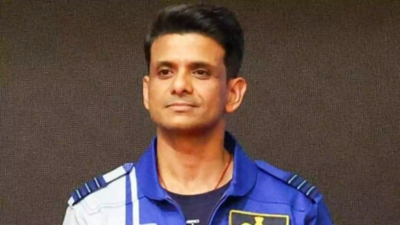The Axiom-4 mission, carrying India's Shubhanshu Shukla alongside Anne McClain, Nichole Ayers, and Peggy Whitson, successfully launched from NASA's Kennedy Space Center on Wednesday at 12:01 pm IST. The mission will transport these four private astronauts to low Earth orbit for a two-week stay dedicated to scientific research at the International Space Station (ISS). Docking is scheduled for 4:30 pm IST on Thursday at the orbital outpost's space-facing port on the Harmony module.

This timeline translates to roughly 28.5 to 29 hours from launch to docking. Once there, the crew will dedicate approximately two weeks to conducting scientific research and participating in outreach activities.
The journey began at Launch Complex 39A at NASA's Kennedy Space Center in Florida, a site steeped in history as the departure point for Neil Armstrong's historic Moon mission. The Ax-4 crew, donned in specialized flight suits, arrived at the launch pad and entered the Dragon capsule "C213" where they conducted pre-launch verifications with SpaceX and NASA teams.
Approximately 35 minutes before launch, the Launch Director authorized fueling after the crew's emergency escape mechanism was activated. The Falcon-9 rocket then received its supercooled liquid oxygen and RP-1 kerosene fuel. With five minutes remaining on the countdown, the Dragon capsule transitioned to internal power, requiring complete synchronization of all systems.
At T-0, Falcon-9's nine Merlin engines roared to life, propelling the vessel skyward. Within the first sixty seconds, the craft broke the sound barrier. The critical "Max Q" phase, where the vehicle experienced peak aerodynamic stress, occurred at 57 seconds.
The vessel maintained its precise trajectory toward low-Earth orbit (LEO), with the crew experiencing intensifying gravitational forces.
Around 150 seconds after launch, the first stage detached and initiated its return to Earth, targeting an automated landing on an Atlantic Ocean platform. Meanwhile, the second stage continued to propel Dragon towards its intended orbit.
Ten minutes after launch, Dragon separated completely and began its independent flight. The nose cone opened, revealing essential navigation equipment. The spacecraft accelerated to speeds exceeding 27,000 km/hr, completing Earth orbits every 90 minutes.
The subsequent 20-24 hours involved meticulous orbital adjustments. Dragon executed a series of calculated engine burns to precisely align with the ISS's trajectory. The spacecraft relied on a combination of GPS, radar, and internal sensors for accurate positioning.
Dragon approached the ISS methodically, pausing at designated waypoints from 400 meters inward. Ground control provided authorization for each progression. At 20 meters, the spacecraft's laser sensors and cameras guided it towards the Harmony module's docking port.
The connection unfolded in two phases: magnetic soft capture, followed by mechanical hard capture, creating an airtight seal between the spacecraft and the ISS.
Following rigorous pressure and leak verification, the crew entered the International Space Station. The Ax-4 team then initiated their two-week scientific program, which includes research into diabetes. For Shubhanshu Shukla, this mission marks not only a personal milestone but also signifies India's increasing presence in space exploration.
Newer articles
Older articles
 Gavaskar Calls for Kuldeep Yadav's Inclusion in Second Test Amid Bumrah Fitness Concerns, Cites Edgbaston Spin Advantage
Gavaskar Calls for Kuldeep Yadav's Inclusion in Second Test Amid Bumrah Fitness Concerns, Cites Edgbaston Spin Advantage
 Indian Astronaut Shukla Arrives at ISS, Ushering in New Era for Space Program
OR
India Celebrates as Shukla Reaches ISS, Advancing Ambitious Space Goals
Indian Astronaut Shukla Arrives at ISS, Ushering in New Era for Space Program
OR
India Celebrates as Shukla Reaches ISS, Advancing Ambitious Space Goals
 Rishabh Pant Revolutionizing Cricket, Says Greg Chappell
Rishabh Pant Revolutionizing Cricket, Says Greg Chappell
 Toxic Workplace Warning Signs: Spot the Red Flags Early
Toxic Workplace Warning Signs: Spot the Red Flags Early
 Indian Cricket Star Mukesh Kumar and Wife Divya Singh Announce the Arrival of Baby Boy
Indian Cricket Star Mukesh Kumar and Wife Divya Singh Announce the Arrival of Baby Boy
 Global Immunization Crisis: Millions of Children at Risk as Vaccine Coverage Lags, Study Reveals
Global Immunization Crisis: Millions of Children at Risk as Vaccine Coverage Lags, Study Reveals
 Moto G54 Price Slashed in India: Check Out the Discounted Rates and Specs
Moto G54 Price Slashed in India: Check Out the Discounted Rates and Specs
 IRCTC Launches AI Chatbot 'AskDisha 2.0' to Revolutionize Train Ticket Booking and Customer Service
IRCTC Launches AI Chatbot 'AskDisha 2.0' to Revolutionize Train Ticket Booking and Customer Service
 Cummins Lauds Australia's Dominant Start to WTC Campaign After West Indies Series Win
Cummins Lauds Australia's Dominant Start to WTC Campaign After West Indies Series Win
 Smith Targets Test Return After Innovative Baseball Cage Rehab in New York
Smith Targets Test Return After Innovative Baseball Cage Rehab in New York